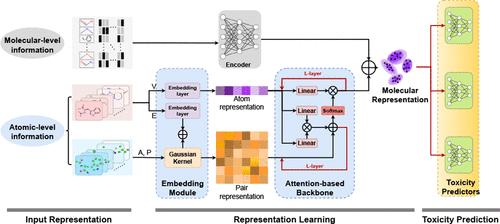Multiscale-Information-Embedded Universal Toxicity Prediction Framework
IF 11.3
1区 环境科学与生态学
Q1 ENGINEERING, ENVIRONMENTAL
引用次数: 0
Abstract
Hazard identification and labeling of industrial chemicals and their released environmental pollutants are crucial for mitigating ecological and health risks. Comprehensive evaluation of multiple toxicity end points is essential to fully characterize chemical hazards. Existing deep-learning-based toxicity prediction models often exhibit poor generalizability, especially for rare toxicities with sparse data. Most studies fail to capture the three-dimensional (3D) spatial arrangement and stereochemical properties of chemicals, as well as the interrelated nature among end points, hindering accurate toxicity profiling. Here, we propose ToxScan, an SE(3)-equivariant multiscale model, as a universal toxicity prediction framework to address these issues. It incorporates 3D geometry information through a two-level molecular and atomic representation learning protocol. A parallel multiscale modeling and a multitask learning scheme are applied to learn universal toxicological characteristics. Results show that ToxScan achieves 7.8–37.6% improvements over state-of-the-art models for medium-/small-scale end points, demonstrates differentiation of structural analogues with contrasting toxicities, and maintains generalizability to environmental pollutants. Interpretability analysis at the atomic and molecular levels reveals identifiable atomic interaction patterns and potential structural alerts. Case studies reveal its capacity to detect subtle structural determinants while elucidating the mechanisms of pollutants. To facilitate user accessibility, we provide an intuitive web platform (https://funmg.dp.tech/Toxscan) for the rapid prediction of multiple toxicity end points of new compounds.

多尺度信息嵌入通用毒性预测框架
工业化学品及其释放的环境污染物的危险识别和标签对于减轻生态和健康风险至关重要。综合评价多种毒性终点是充分表征化学危害的必要条件。现有的基于深度学习的毒性预测模型通常表现出较差的泛化性,特别是对于具有稀疏数据的罕见毒性。大多数研究未能捕捉到化学物质的三维空间排列和立体化学性质,以及端点之间的相互关联性质,从而阻碍了准确的毒性分析。在这里,我们提出ToxScan,一个SE(3)等变多尺度模型,作为一个通用的毒性预测框架来解决这些问题。它通过两级分子和原子表示学习协议融合了三维几何信息。采用并行多尺度建模和多任务学习方案学习通用毒理学特征。结果表明,与最先进的中/小规模终点模型相比,ToxScan实现了7.8-37.6%的改进,展示了具有不同毒性的结构类似物的差异,并保持了对环境污染物的普遍性。原子和分子水平的可解释性分析揭示了可识别的原子相互作用模式和潜在的结构警报。案例研究揭示了它在阐明污染物机制的同时检测细微结构决定因素的能力。为了方便用户访问,我们提供了一个直观的web平台(https://funmg.dp.tech/Toxscan),用于快速预测新化合物的多个毒性终点。
本文章由计算机程序翻译,如有差异,请以英文原文为准。
求助全文
约1分钟内获得全文
求助全文
来源期刊

环境科学与技术
环境科学-工程:环境
CiteScore
17.50
自引率
9.60%
发文量
12359
审稿时长
2.8 months
期刊介绍:
Environmental Science & Technology (ES&T) is a co-sponsored academic and technical magazine by the Hubei Provincial Environmental Protection Bureau and the Hubei Provincial Academy of Environmental Sciences.
Environmental Science & Technology (ES&T) holds the status of Chinese core journals, scientific papers source journals of China, Chinese Science Citation Database source journals, and Chinese Academic Journal Comprehensive Evaluation Database source journals. This publication focuses on the academic field of environmental protection, featuring articles related to environmental protection and technical advancements.
 求助内容:
求助内容: 应助结果提醒方式:
应助结果提醒方式:


